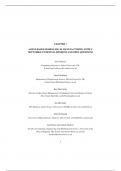CHAPTER ? AGENT-BASED MODELLING IN MANUFACTURING SUPPLY NETWORKS: POTENTIAL BENEFITS AND OPEN QUESTIONS Ani Calinescu Computing Laboratory, Oxford University, UK, E-mail:Ani.Calinescu@comlab.ox.ac.uk Janet Efstathiou Department of Engineering Science, Oxford University, UK, E-mail:Janet.Efstathiou@eng.ox.ac.uk Bart MacCarthy Division of Operations Management, Nottingham Uni versity Business School, UK, E-mail: Bart.Maccarthy@nottingham.ac.uk Ian McCarthy SFU Business, Simon Fraser University, CANADA, E-mail: imccarth@sfu.ca Abhi Deshmukh University of Massachusetts, Amherst, USA, E-mail: deshmukh@ecs.umass.edu Ian Parmee and Azahar Machwe Faculty of Computing, Engineering and Mathematical Science, University of the West of England, UK, E-mail: Ian.Parmee@uwe.ac.uk and Azahar.Machwe@uwe.ac.uk 1 Modern manufacturing supply networks are challenged by demands for flexible responses to demanding customers who require rapid delivery of customized products. Traditional methods of simulation and optimization do not capture enough of the complexity of information flow and agent behaviour to provide adequate means of meeting the challenges to understand and design responsive, customizing manufacturing supply networks. We describe and review three novel approaches to modelling and simulating supply networks and identify the challenges that agent-based modelling can help address in the near future. 1. Introduction Manufacturing and supply networks are becoming distributed, virtual organizations, expected to respond flexibly and reliably to unscheduled requests for customized products. In distributed organizations, separate autonomous agents are co-operating on shared goals, using different subsets of information, with some portion of their operating perspective communicated to their partners within the manufacturing organization or network. These new, complex manufacturing and supply systems are characterised by dynamic, uncertain, incomplete and often poor quality information, and by mechanisms of transmitting and processing information that are difficult to define and control. Furthermore, due to the incomplete definition of decision variables, constraints and objectives, business, industrial and economic systems are often characterised by a mixture of formal and informal decision-making, and by a significant reliance on human judgment, control and response1. On the other hand, such systems can also operate efficiently and robustly, adapting their structure and behaviour to the environment 2-4. This chapter presents examples of recent work, from a variety of perspectives, on how an understanding of the properties of complex, dynamic networks in the life and/or social sciences may contribute to improved performance of engineered, designed or evolved networks to support the new manufacturing and supply networks. For these, and many other reasons, it is important that the domain of operations management learns from the structure and performance of other 2 networks in order to find out if the desirable characteristics of such networks may be transferred to the designed networks on which so much of modern life depends. The structure of this chapter is as follows. Section 2 describes in more detail the challenging modern manufacturing context within which goods and services are ordered, manufactured and distributed. Section 3 reviews briefly the use of agent-based modelling (ABM) in manufacturing supply networks, before presenting three case studies that illustrate different aspects of agent-based modelling in this context. Section 4 concludes the chapter with a discussion of the three case studies and suggestions for the research questions ahead. 2. The Manufacturing Context Within manufacturing supply networks, organizations are characterized by ever-increasing demands for flexibility in processes and in product ranges, and by a high range of customers and suppliers5-7. Mass customization and e-manufacturing are the differentiating paradigms for competitive advantage8-11. Moreover, the uncertainty and variability due to customer changes and unreliable information, material and resources may reduce the predictability and controllability levels in such systems. These characteristics and constraints are propagated and amplified along the supply chains3,12,13. The challenge of planning and control increases with the scale of operations. Organizations may produce a wide range of products for a wide range of customers, with both changing over time. There is an increasing need to customize products for niche markets and produce ‘total solutions’ for individual customers9. Time-based competition is now a reality, even in traditional sectors such as steel14. Pressures on costs exist in all sectors. Large numbers of firms are now operating across multiple locations internationally with complex networks of suppliers, production facilities and distribution channels serving local, regional and international markets. Not surprisingly then, putting in place effective operations planning, scheduling and control structures is challenging, as is managing them effectively over time. 3




